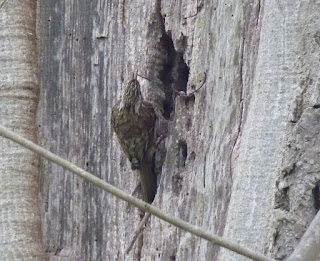A good website is the British Trust for Ornithology. There are many sites providing information about birds but the BTO has 'unbiased information about birds' and undertakes research. For example, the tracking of Cuckoo Stanley has attracted nationwide interest after it was found where cuckoos go for the winter. Stanley returned to the uk in early April from the Ivory Coast.
I went to the information about the Nuthatch and followed a link to recordings of its songs, calls, male calls, alarm calls and so on.
This was really useful to me . I hadn't really understood the range of sounds each bird makes and when I go for the walk this morning I'll be much more confident of locating the Nuthatches from their sounds.
I'm keen to get a decent picture of a Treecreeper. It's a small bird, moves quickly but has a distinctive song so I'm more confident now of finding one. That doesn't mean I will actually see one of course. Here's some not so good pictures of one I took a while ago.

















